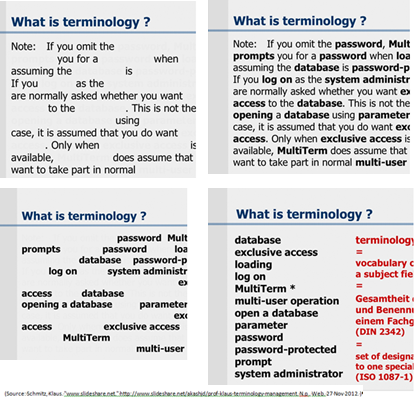This content has been archived. It may no longer be relevant
This month, we are featuring three blogs on a very complex and interesting topic – terminology in translation. So, if by chance you do not find the information you are looking for in one blog, you may find it in another. Our first blog will address, “What is Terminology in Translation?” Then, the second blog will talk about “Terminology Management in Translation.” Finally, the last blog of 2012 will cover “Why is a Glossary or Term Base Needed for Translation?” We love to hear from you, so please feel free to leave comments.
What is Terminology in Translation?
Let’s start with the definition of terminology itself. According to Wikipedia, “Terminology is the study of terms and their use. Terms are words and compound words that in specific contexts are given specific meanings, meanings that may deviate from the meaning the same words have in other contexts and in everyday language.”
In the context of translation, terminology is just as critical as it is in the original language. But what specific benefits result from this approach?
Benefits of Terminology in Translation
– This helps to ensure transparency and consistency in all documentation
– It also enhances linguistic correctness
– And it likewise improves the quality of documentation and corporate language
– Makes work easier for everybody in the company and for your partners, i.e. Language Service Provider
– Reduces volume of content for translations as text can be re-used
– Finally, it saves time which could speed up your time to market
How to Store Terminology?
If you haven’t started a list of terminology yet, we suggest beginning with an Excel spreadsheet and your source language. First, determine terms in your language. Ask the technical writers and marketing department to approve them. Then, translate the terms into your target languages. You can do this by adding language columns in the spreadsheet. First, you should translate terminology while translating text, since translators may understand terminology better within context. Of course, when you use this approach, you can find more appropriate terms in the target languages. Your Excel spreadsheet might serve the purpose as your terminology database for a long time. However, if you outgrow it and want to invest in better technology, there are several tools on the market.
Sharing Terminology
Please share your approved terminology with anyone in your company, particularly individuals responsible for creating and managing documents. Examples of such individuals include technical writers, marketing and media departments and/or partners, publishers, PR representatives, your language service provider, etc. Be sure to include all your different locations and markets. In this way, you’ll inform everybody about your corporate language.
Translation Services
Perhaps you’re in the process of creating a terminology list for your organization’s content. So, if you plan to make that content available to speakers of other languages, there’s a good chance you’ll be needing translation services. That’s where TrueLanguage can help. Interested? Reach out to us for a cost-free, no-obligation quote today!



maybe you should start by using the correct terminology – what you mean by “blog” is in fact a “post”. A “blog” is
website or web page where opinions, links to other sites, etc. are recorded on a regular basis, a “post” is the actual content.
Your feedback is highly appreciated. We would like to refer to Wikipedia with the answer: A blog (a portmanteau of the term web log)[1] is a discussion or informational site published on the World Wide Web and consisting of discrete entries (“posts”) typically displayed in reverse chronological order (the most recent post appears first).